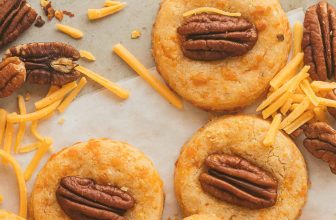
Become a Food Processing Pro
1. In the work bowl of a food processor, place flour and salt; pulse until combined. Add butter, and pulse until mixture is crumbly and butter is pea-size, 12 to 15 pulses. What does it mean to be “pea-size”? Look for the largest bits of butter—those should be close to the size of a common pea. The rest of the butter-flour mixture will appear mealy, like coarse-ground cornmeal or grated Parmesan cheese. Be vigilant, as you can over process the mixture and begin to cream it if you are not watching. Once the mixture is overprocessed, you won’t be able to get those ideal lumps of butter back. It’s the chunks of butter that ultimately create the flaky, buttery crust we all know and love.
2. In a small bowl, combine ½ cup (120 grams) cold water and vinegar. With processor running, add vinegar mixture to flour mixture in a slow, steady stream just until dough comes together.
3. Mixture will look crumbly, but it should stick together when squeezed between your fingers. This crumbly dough may appear a bit messy, but this hydration level is ideal to limit gluten formation. Flour, depending on how it was processed and where it is stored, will absorb liquids at different rates. We control the hydration factor by adding the vinegar mixture just until the dough begins to pull away from the sides of the food processor bowl. Once this happens, you can discard any additional liquid that you did not use—you won’t need it.
4. Turn out dough. Divide in half, and shape each half into a disk. Wrap tightly in plastic wrap, and refrigerate for at least 2 hours. Dough may be refrigerated for up to 3 days or frozen for up to 2 months. Over time, dough can develop a slight gray tinge due to oxidation. The addition of vinegar in the dough helps to slow this process, keeping your dough closer to its original color during storage.
UNDER THE MICROSCOPE
When we talk about protein in flour, the conversation often leads to gluten, but through a magnified lens, there are actually two proteins that add to the story. In short, these are called glutenin and gliadin. As these two proteins encounter liquid, they bond together, forming the protein complex that gives stretch to dough and creates flaky pastries. This complex is called gluten. Now, the more dough is handled, the stronger the gluten network becomes, and molecules align to create elasticity. With bread, working the dough extensively develops this gluten network, which captures gases, creates rise, and lends the airy crumb and undeniable chewy texture. For pastry, however, we need just enough gluten to hold the delicate pastry together, but not so much that we get a chewy, tough dough. Thus, choosing flour with an intermediate protein content and limiting how much the dough is worked is one simple method that leads to tender, flaky pastries.







